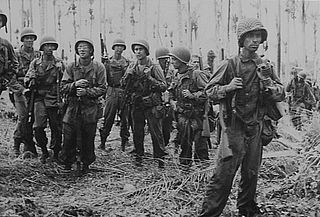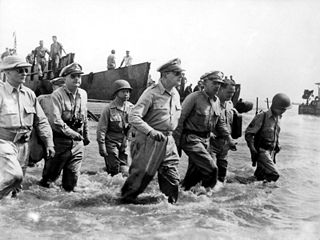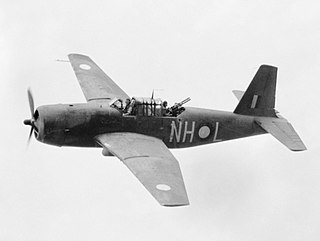Related Research Articles

The Battle of the Bismarck Sea took place in the South West Pacific Area (SWPA) during World War II when aircraft of the U.S. Fifth Air Force and the Royal Australian Air Force (RAAF) attacked a Japanese convoy carrying troops to Lae, New Guinea. Most of the Japanese task force was destroyed, and Japanese troop losses were heavy.

The Battle of Rabaul, also known by the Japanese as Operation R, an instigating action of the New Guinea campaign, was fought on the island of New Britain in the Australian Territory of New Guinea, from 23 January into February 1942. It was a strategically significant defeat of Allied forces by Japan in the Pacific campaign of World War II, with the Japanese invasion force quickly overwhelming the small Australian garrison, the majority of which was either killed or captured. Hostilities on the neighbouring island of New Ireland are usually considered to be part of the same battle. Rabaul was significant because of its proximity to the Japanese territory of the Caroline Islands, site of a major Imperial Japanese Navy base on Truk.

Aitape is a small town of about 18,000 people on the north coast of Papua New Guinea in the Sandaun Province. It is a coastal settlement that is almost equidistant from the provincial capitals of Wewak and Vanimo, and marks the midpoint of the highway between these two capitals. Aitape has 240 V power, telephone, a bank, a post-office, a courthouse and a police station, a supermarket and many tradestores, a petrol station, two airstrips, two secondary schools, a mission office and a hospital.

The New Guinea campaign of the Pacific War lasted from January 1942 until the end of the war in August 1945. During the initial phase in early 1942, the Empire of Japan invaded the Territory of New Guinea on 23 January and Territory of Papua on 21 July and overran western New Guinea beginning on 29 March. During the second phase, lasting from late 1942 until the Japanese surrender, the Allies—consisting primarily of Australian forces—cleared the Japanese first from Papua, then New Guinea, and finally from the Dutch colony.

The New Britain campaign was a World War II campaign fought between Allied and Imperial Japanese forces. The campaign was initiated by the Allies in late 1943 as part of a major offensive which aimed to neutralise the important Japanese base at Rabaul, the capital of New Britain, and was conducted in two phases between December 1943 and the end of the war in August 1945.

The Philippines campaign, Battle of the Philippines, Second Philippines campaign, or the Liberation of the Philippines, codenamed Operation Musketeer I, II, and III, was the American, Mexican, Australian and Filipino campaign to defeat and expel the Imperial Japanese forces occupying the Philippines during World War II.

No. 15 Squadron was a Royal Australian Air Force (RAAF) light bomber and maritime patrol squadron of World War II. The squadron was formed in January 1944 and initially flew anti-submarine patrols off the east coast of Australia. From September that year elements of the squadron took part in the New Guinea Campaign, and the main body of the squadron moved to New Guinea in March 1945. Its duties in New Guinea included anti-submarine and anti-barge patrols as well as attacking Japanese positions. No. 15 Squadron was demobilised after the end of the war, and was formally disbanded in March 1946.

The Markham Valley, Ramu Valley and Finisterre Range campaigns were a series of battles within the broader New Guinea campaign of World War II. The campaigns began with an Allied offensive in the Ramu Valley, from 19 September 1943, and concluded when Allied troops entered Madang on 24 April 1944. During the campaign, Australian forces – supported by Australian and US aircraft – advanced through the Markham Valley and Ramu Valleys during which there were minor clashes with Japanese forces, which withdrew towards their main defensive line in the Finisterre Range.

The Battle of Hollandia was an engagement between Allies of World War II and Japanese forces during World War II. The majority of the Allied force was provided by the United States, with the bulk of two United States Army infantry divisions being committed on the ground. Air and naval support consisted largely of U.S. assets, although Australia also provided air support during preliminary operations and a naval bombardment force.

The Landing at Aitape was a battle of the Western New Guinea campaign of World War II. American and Allied forces undertook an amphibious landing on 22 April 1944 at Aitape on northern coast of Papua New Guinea. The amphibious landing was undertaken simultaneously with the landings at Humboldt and Tanahmerah Bays to secure Hollandia to isolate the Japanese 18th Army at Wewak. Operations in the area to consolidate the landing continued until 4 May, although US and Japanese forces fought further actions in western New Guinea following a Japanese counter-offensive that lasted until early August 1944. Aitape was subsequently developed into an Allied base of operations and was used by Australian forces throughout late 1944 and into 1945 during the Aitape–Wewak campaign.

The Bombing of Wewak was a series of air raids by the USAAF Fifth Air Force, on 17–21 August 1943, against the major air base of the Imperial Japanese Army Air Force on the mainland of New Guinea, at Wewak. The four raids, over a five-day period, represented a decisive victory for the Allies: the Japanese Fourth Air Army lost about 170 planes on the ground and in the air, reducing its operational strength to about 30 planes. Ten aircraft from the U.S. Fifth Air Force were lost.

The Aitape–Wewak campaign was one of the final campaigns of the Pacific Theatre of World War II. Between November 1944 and the end of the war in August 1945, the Australian 6th Division, with air and naval support, fought the Imperial Japanese 18th Army in northern New Guinea. Considered a "mopping up" operation by the Australians, and although ultimately successful for them with the Japanese forces cleared from the coastal areas and driven inland, amidst difficult jungle conditions, casualties from combat and disease were high. With Japan on the verge of defeat, such casualties later led to the strategic necessity of the campaign being called into question.

The Battle of Noemfoor was part of the New Guinea campaign of World War II. It took place on the island of Noemfoor, in Dutch New Guinea, between 2 July and 31 August 1944. During the battle, Allied forces landed on the island to capture Japanese bases as part of their advance through the Pacific towards the Philippines. The initial landing was largely unopposed and the Japanese defenders withdrew inland as the US troops came ashore. Sporadic fighting took place over the course of two months as the Allies secured the three airfields on the island and pushed the surviving Japanese troops to the southeastern coast. The island was later used by the Allies to support operations around Sansapor and on Morotai.

The landing at Saidor, codenamed Operation Michaelmas, was an Allied amphibious landing at Saidor, Papua New Guinea on 2 January 1944 as part of Operation Dexterity during World War II. In Allied hands, Saidor was a stepping stone towards Madang, the ultimate objective of General Douglas MacArthur's Huon Peninsula campaign. The capture of the airstrip at Saidor also allowed construction of an airbase to assist Allied air forces to conduct operations against Japanese bases at Wewak and Hollandia. But MacArthur's immediate objective was to cut off the 6,000 Imperial Japanese troops retreating from Sio in the face of the Australian advance from Finschhafen.

No. 71 Wing was a Royal Australian Air Force (RAAF) wing of World War II. It was formed in February 1943 at Milne Bay, Papua New Guinea, as part of No. 9 Operational Group. The wing initially comprised two squadrons of P-40 Kittyhawks, one of Lockheed Hudsons, and one of Bristol Beauforts. The wing's mainstay soon became the Beaufort, which eventually equipped five squadrons attached to the formation. No. 71 Wing took part in the New Guinea campaign under the auspices of No. 9 Group, before transferring to No. 10 Operational Group for the Western New Guinea campaign during 1944. It then returned to the control of Northern Command to support Australian ground forces in the Aitape–Wewak campaign, and completed its final combat mission only hours before the Japanese surrender in August 1945. No. 71 Wing remained in New Guinea following the war and was disbanded in January 1946.

Aikoku Maru (愛国丸) was an armed merchant cruiser of the Imperial Japanese Navy in World War II. The ship entered service in 1940, the ship was later converted to an ammunition ship. She was sunk in February 1944 during Operation Hailstone.

The Battle of Madang, fought between early February and late April 1944, was the break-out and pursuit phase of the Markham and Ramu Valley – Finisterre Range and Huon Peninsula campaigns, which were part of the wider New Guinea campaign of World War II. After overcoming the Japanese defences around Shaggy Ridge, the Australian forces descended the steep slopes of the Finisterre Range and pursued the withdrawing Japanese towards Bogadjim and then Madang on the north coast of New Guinea. There they linked up with US and Australian forces that had advanced along the coast from the Huon Peninsula, while the remnants of three Japanese divisions withdrew towards Wewak, where further fighting would take place throughout late 1944 and into 1945.
The Landing on Long Island in the Territory of New Guinea was part of the Huon Peninsula campaign, a series of operations that made up Operation Cartwheel, General Douglas MacArthur's campaign to encircle the major Japanese base at Rabaul. Located at the northern end of the Vitiaz Strait, Long Island was an important staging point for Japanese barges moving between Rabaul and Wewak until 26 December 1943, when a force of 220 Australian and American soldiers landed on the island. It was not occupied by the Japanese at the time, and there was no fighting. At the time, it represented the furthest Allied advance into Japanese-held territory. It was developed into a radar station.

The Royal Australian Air Force (RAAF) operated Vultee Vengeance dive bombers during World War II. The Australian Government ordered 297 of the type in late 1941 as part of efforts to expand the RAAF. This order was later increased to 400 aircraft. A few Vengeances arrived in Australia during 1942, and large-scale deliveries commenced in early 1943; further orders were cancelled in 1944 after 342 had been delivered.

US Naval Base New Guinea was number of United States Navy bases on the Island of New Guinea during World War II. Australia entered World War II on 3 September 1939, being a self-governing nation within the British Empire. The United States formally entered the war on 7 December 1941, following the Empire of Japan bombing of Pearl Harbor. Following the attack on Pearl Harbor Japan quickly took over much of the South Pacific. The United States lost key Naval Bases in the South Pacific including: Naval Base Manila and Naval Base Subic Bay lost in the 1941 invasion of the Philippines. Also lost was Naval Base Guam and Wake Atoll. As such the United States Armed Forces needed new bases in the South West Pacific for staging attacks on Japan's southern empire, the United States built bases first in Australia, then in New Guinea.
References
- Pacific Wrecks Homepage
- Intelligence and Military Operations by Michael I.(ed.) Handel at Google Books
- Chapter VI - The Westward Drive Along New Guinea Archived 2017-07-15 at the Wayback Machine from Reports of General MacArthur The Campaigns of Gen. MacArthur in the Pacific – Vol. 1
- A Chronology of Australian Armed Forces at War 1939-45 by Bruce T. Swain at Google Books